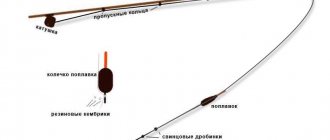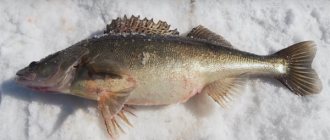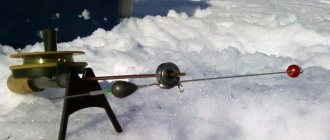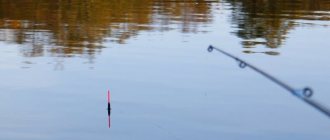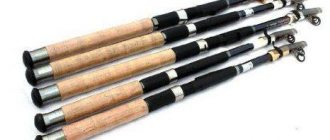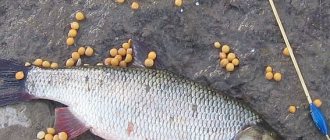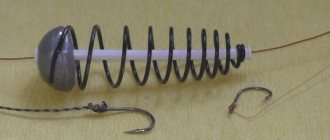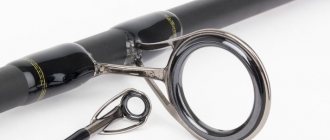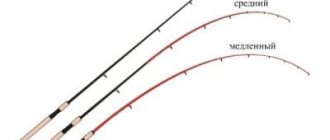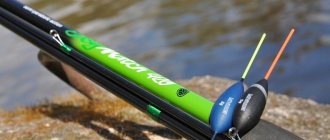How to make a whip
If you wish, you can fish by lowering a line with bait and a hook into the hole directly from the reel, but this method is unlikely to be convenient for anyone, not to mention its relatively low productivity. To make it easier to hold the fishing rod in your hand, you need a whip and a fishing rod, which ensures the strength of the tackle when biting and removing even relatively large fish from the water. One of the main characteristics of the whip is its flexibility, due to which the fisherman can play with jigs and spoons.
In addition, if you fish with a balance beam, this element will serve as a nod, signaling the fisherman about the bite. A whip of suitable length and sufficiently strong is often made independently, using separate pieces of polycarbonate, fiberglass, or even better - titanium. Each of these methods has its own manufacturing characteristics.
To create a whip made of polycarbonate, you will need a blank of this material at least 18 cm long. With a wide base, it should taper in its upper part. In the future, the bottom of the whip will be attached to the handle of the fishing rod, so these parts must match. If the width of the product is greater than the permissible values, then the workpiece will have to be cut down with sandpaper or a knife and sanded well. Sixes for winter polycarbonate fishing rods can also be used for fishing with a jig.
Fiberglass for making a whip would be appropriate if a narrower part is required. To obtain such a thin and long element, it is enough to cut the workpiece from the specified material with sandpaper, removing excess thickness and width.
Important! To prevent excess dust from settling on your hands and getting into your respiratory tract, it is better to form fiberglass under running water.
Whips made of titanium alloy are even stronger and stiffer than the previous version, so when using them, it is worth adding an elastic nod to such a whip, possibly from a simple spring. This product option is perfect for winter fishing at great depths, where the use of weighted bait and thick fishing line is required.
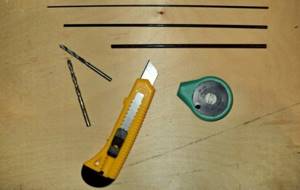
Advice from the experts
So, we briefly learned what the two versions of fishing rods in the average configuration consist of. Now let's talk to experts who have independently made more than a dozen winter fishing rods, both for jig fishing and for trolling.
Nikita (ndup):
— Good afternoon, dear friends, today I will tell you how to make a couple of types of fishing rods with your own hands. The simplest and most effective fishing rod that you can make in a short period of time with your own hands is the so-called Shcherbakov fishing rod. It's very easy to do! After the New Year's table, a wine or champagne cork remains (made of cork material, not plastic!), carefully grind the area under the fishing line and glue the six with super glue. The main thing is that the six is cushioned, and when there is a bite, the line begins to be released from the plug, that is, some analogue of a friction is obtained.
,

In the photo: a homemade cork fishing rod.
The advantage of such a fishing rod is its ease of manufacture, and it does not take up much space. Another big plus is the low weight of this design. The downside is that the fishing line is wound by hand; this fishing rod does not have any spools.
Another simple and easy-to-make fishing rod is the filly. You can fish with it not only using a jig, but also with a spinner.

In the photo: a homemade foam fishing rod.
It’s also easy to do, take a piece of foam or cork material and grind down the area for the fishing line. We drill a hole into which we insert a six-piece about 20-30 cm long and that’s it. The fishing line on this design is also wound by hand, there are no spools.
You can also watch a video where I modified the nod for a winter fishing rod with my own hands.
Igor ( IVH):
- Every fisherman, whether a beginner or an experienced one, no matter, over time, after going shopping, accumulates a certain amount of bait - spinners, balancers and many other fishing goodies. It is no secret that a huge number of winter fishing enthusiasts hunt precisely for predatory fish - perch, pike perch, pike, burbot. But the baits, of course, are different for each predator - they differ in size, weight and other parameters.

How to adapt to these different baits? Some people purposefully catch perch, while others only like winter fishing rods for balance. That is, you will have to have in the box a whole bunch of different lures with different degrees of hardness and length of the whips? What if all these fish species are present in a given place?
Alternatively, you can get by with store-bought sparklers, of which there are now plenty of assortments, but in my opinion, it’s better than your own, made by yourself – no! It meets all the necessary parameters of a fisherman - weight, length, whip hardness or, on the contrary, softness. Here everyone chooses for themselves. In store-bought fishing rods, these parameters may not be the same. Therefore, at one time I was also puzzled by this question - what the stores offered did not suit my fishing conditions. It just didn’t fit in my hand - and I didn’t want to feel discomfort while fishing. After all the thinking, I came to a clear decision - it’s time to start making a fishing rod to suit your needs.
After many years of experience in making such gear, I can say that there are a great many options. However, they all differ only in nuances.
In general, there are two types of fishing rods - with a reel and without a reel. The second option is the simplest - a variety of fillies, pistols and any shape of handle made of lightweight material, for example, foamed PVC. For example, I made it from polystyrene foam, pine bark and other unusual materials. Such fishing rods are the lightest and most weightless. But one inconvenience with such fishing rods is that you have to wind the line by hand. When moving from hole to hole, the whole thing gets confused... You waste time unwinding, you get nervous... Is this really necessary when fishing?
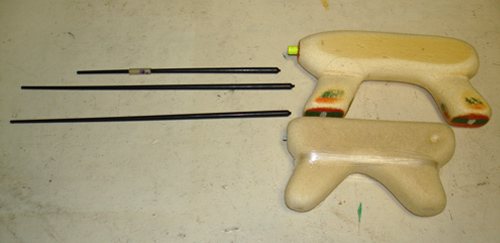
That is why I consider a fishing rod and reel to be the best option for winter trolling for perch. The fishing line for winter fishing is quickly released and reeled in. A homemade fishing rod with a reel can be made from anything. But the best option, in my opinion, is a cork handle from an old spinning rod with a reel seat. Simply cut to the required length and capped at the end.
How to make a reel
A reel for a winter fishing rod is one of the most important elements of the finished structure, since it is with its help that you can use the fishing line in doses and it is much more convenient to pull it out of the ice hole. Ready-made plastic or metal products are sometimes quite expensive, so to save money you can try to create the part yourself. The most affordable and suitable material for implementing the idea would be hard foam, which, among its other advantages, is also characterized by the ease of staying afloat. The optimal diameter of the finished coil should be 80–85 mm, with a thickness of at least 20 mm.
To make a coil cutter, a regular nail with the head removed is used, pre-cut on both sides and bent in two places at right angles. Next, at the location of the cutter, you need to pierce the foam with an awl and insert a nail, and then cut a groove with a sharp knife and clean it with sandpaper, after which the part is considered ready. The only addition that is required in this case is a metal base that protects the foam from mechanical damage and secures it to the handle.
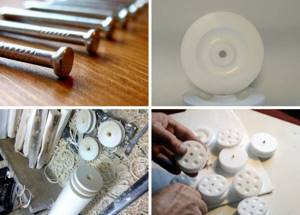
How to make a pen
When staying near an ice hole for a long time, it is extremely inconvenient to constantly hold a fishing rod, so its handle should be as light as possible and correspond to the shape of the palm. When making such a part yourself, you can use foam plastic, champagne corks or even toothbrushes as a suitable material, naturally after their preliminary preparation. Wooden products weigh a little more, so they are not always comfortable to hold.
Important! Don't try to make the hole for the whip very large. The base of the fishing rod should be tightly attached to its handle.
From foam plastic
If, when choosing a material to create a handle, you paid attention to dense and hard foam, be prepared to process it using a stationery knife, file or even sandpaper, which will help give the unattractive material a suitable shape. In the standard version, there should be a protrusion at the top of the finished handle for winding fishing line, and two wide legs at the bottom. In the end section of the part, it is necessary to make a longitudinal hole, 20–30 mm deep, into which a whip will later be placed and the fishing line will be stretched.
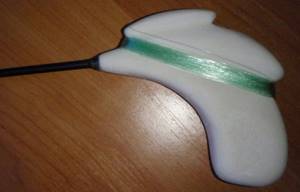
From the traffic jam
The simplest fishing rod can be made from cork, despite the fact that its shape will not be as comfortable for the palm as the foam version.
To achieve the desired result, you must adhere to the following scheme of actions:
- Prepare several plugs and make holes in them strictly in the middle, and the diameter of such recesses should be less than the thickness of the whip made earlier.
- Connect several plugs with thick wire and fill with epoxy glue.
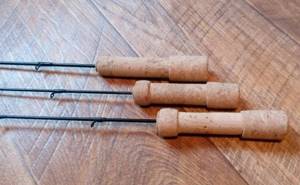
The last plug, to which the whip will be attached in the future, is put on the wire only halfway, leaving room for the continuation of the rod.
From a toothbrush
The plastic from which modern toothbrushes are made turns out to be a fairly durable material, so it can also be used to create the handle of a winter fishing rod. An additional advantage of this particular base is the presence of rubber pads on the handle and the fact that the brush itself fits comfortably in the human palm.
Did you know? The world's first metal hooks and fishing line for fishing rods appeared in Ancient China more than two and a half thousand years ago, which is mentioned in the ancient writings of the Celestial Empire.
To give the workpiece the desired shape, you can simply cut off the bristles with a knife and sharpen the tip of the plastic in order to later secure the whip or straight nod (depending on the length of the brush). The remaining parts of the homemade fishing rod are attached to the prepared base using the same epoxy glue.
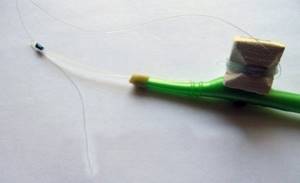
Feeders (general description)
The simplest feeder is an ordinary mesh bag with holes, at the bottom of which there are heavy stones. Ordinary feeders differ from each other in the number of holes. For standing water, there are quite a lot of holes in the feeder so that the bait is evenly scattered along the bottom. In reservoirs with fast currents, the holes in the feeder are made an order of magnitude smaller so that the current does not wash out the bait too quickly. Modern and more complex types include feeder feeders. Such feeders are universal and perform two functions at once (groundbait and bait), which are always nearby.
Making a feeder (feeder)
You can make the simplest feeder yourself. For example, let's take a feeder type feeder in the form of a spring or snare.
The feeder feeder is very popular among fishermen; it gained fame because of its versatility. The uniqueness of this bait is that the hooks are located directly in the bait.
To make it, we need a small piece of wire, preferably made of non-ferrous metal; it is better to use copper. We twist the wire in a spiral from the center with a constant decrease in the diameter of the ring, four turns in each direction. We fix a steel rod between the two ends inside the spring.
It is recommended to fuse the bottom of the feeder with a small amount of lead to weigh it down so that a small current does not carry the feeder away when the bait dissolves. We install rings at the top and bottom for attaching leashes with hooks.
How to assemble a winter fishing rod with your own hands
Having prepared the main components of a homemade fishing rod for winter fishing, all that remains is to connect them together, sometimes using glue for better fixation. If there is no reel, you can secure the fishing line by pressing it to the handle with a clamp, and winding the remaining part onto a bottle cap fixed to the side (with slits made along the edges).
This process requires the following steps:
- First of all, insert the whip into the appropriate hole in the handle and pour a little epoxy glue into the recess, waiting for it to dry completely.
- Place a nod on the whip (can be made from boar bristles) and adjust it.
- Attach a spool of fishing line to the handle, and then lay the thread along the whip and nod.
- Attach hooks and a lure to the end of the fishing line, after which you can use the fishing rod for its intended purpose.
Video: how to make a winter fishing rod with your own hands

DIY pocket fishing rod from a syringe
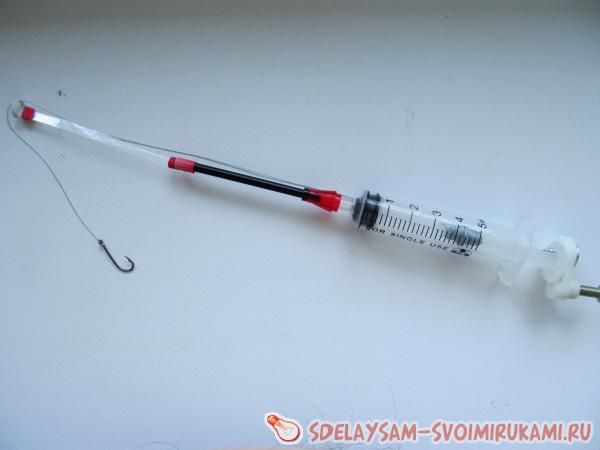
Materials and tools for making a fishing rod: - syringe (the author uses a small one with 5 cubic meters); - screwdriver; - bolt and self-tapping screw; - Super glue; - stationery knife; - plastic bottle; - some elements from Lego; - red and white cambric.

The process of making a pocket fishing rod:
Step one. We make a coil
The line in the fishing rod will be wound around the piston, for this it needs to be modified. Take a stationery knife and use it to cut a groove for the fishing line in the piston body. Next, take a syringe and make a hole in it through which the fishing line will insert the syringe. It can be made with a hot needle, but it is better to pierce it with something, otherwise a bulge will form on the other side of the hole, which can interfere with the operation of the coil.
Receive a selection of new homemade products by email. No spam, only useful ideas!
*By filling out the form you agree to the processing of personal data
What gear is needed for a fishing rod
The simplest tool for winter fishing is deservedly considered a float rod or even a spinning rod if we are talking about non-freezing reservoirs. However, for productive fishing you will also need bottom gear, equipment for jig fishing and fishing rods for fishing using spoons. Unfortunately, in an unfamiliar area, it is quite difficult to predict which type of product is best to use, so if possible, it is worth preparing several options at once.
Did you know? The first artificial raw material for the mass production of fishing line on an industrial scale was nylon, and this happened almost immediately after the material itself was invented in 1937.
As bait, you can use either live bloodworms or larvae, or artificial silicone multi-colored fish or even shapeless bait products. In modern fishing stores, customers are sometimes offered flavored fish baits, but here it is worth taking into account the preferences of the specific species that you are going to “hunt”.
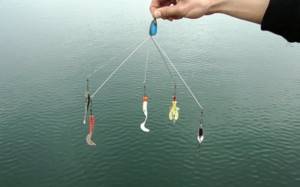
By visiting specialized points of sale of fishing equipment, you can find a wide variety of tools and equipment for winter fishing. But if you are not a frequent visitor to frozen bodies of water, then you can get by with a homemade fishing rod with a minimum set of additional gear. It’s quite simple to make, and a successful and big catch will await you as a reward for your time spent.
What does a winter fishing rod consist of?
Both options, a fishing rod for fishing with a jig and a fishing rod for fishing with bulky lures, are somewhat similar, but at the same time there are slight differences between them.
A winter fishing rod for jig fishing most often consists of the following components: a reel or reel (both options serve as a handle), a pole and a nod. Additions are possible, but this is the classic version.

In the photo: an example of a classic winter balalaika fishing rod.
A winter fishing rod for fishing with bulky baits is equipped with different “ingredients”, the set of which depends on the fishing method: fishing with light or heavy baits.
In the first case, the fishing rod consists of a fishing rod, which acts as a handle, a reel, a whip and a nod. Moreover, if you use a flexible whip, you don’t need to use a nod.

In the photo: an example of a classic winter fishing rod, filly.
In the second case, when you go fishing with heavy baits, you will need serious, durable tackle, which, when animated, places higher demands on strength and rigidity than tackle for fishing with a jig. Such fishing rods are equipped with a short form, with several guide rings, including a tulip, and a handle on which either a spinning or multiplier reel is attached.

In the photo: an example of a winter fishing rod with an inertial reel.

